Which of the following examples represents periodic motion ?
(i) A swimmer completing onė (return) trip from one bank of a river to the other bank.
(ii) A freely suspended bar magnet displaced form its N-S direction and released.
(iii) Halley's comet
(iv) A hydrogen molecules rotating about its centre of mass.
(v) An arrow released from a bow.
To determine which of the given examples represents periodic motion, we first need to understand what periodic motion is. Periodic motion is defined as motion that repeats itself at regular intervals of time. Let's analyze each option step by step.
Step 1: Analyze the swimmer's motion.
- A swimmer completing one return trip from one bank of a river to the other bank involves back and forth movement. However, the time taken for each trip can vary based on various factors (like current, swimmer's speed, etc.). Therefore, this motion does not repeat at regular intervals.
Conclusion: This is not periodic motion.
Step 2: Analyze the freely suspended bar magnet.
- A freely suspended bar magnet, when displaced from its north-south direction and released, will oscillate around its mean position until it returns to the north-south alignment. This oscillation occurs at regular intervals.
Conclusion: This is periodic motion.
Step 3: Analyze Halley's comet.
- Halley's comet has a predictable orbit and returns to the vicinity of Earth approximately every 76 years. While this is a periodic event, the actual motion of the comet through space is not a simple repetitive motion in the same way as oscillations or rotations.
Conclusion: This is not periodic motion in the strict sense of repeating motion.
Step 4: Analyze the hydrogen molecule.
- A hydrogen molecule rotating about its center of mass can be considered to exhibit periodic motion as it oscillates around its center of mass, returning to its original position at regular intervals.
Conclusion: This is periodic motion.
Step 5: Analyze the arrow released from a bow.
- When an arrow is released from a bow, it travels in a straight line and does not return to its original position. Once released, it does not repeat its motion.
Conclusion: This is not periodic motion.
Final Summary:
The examples that represent periodic motion are:
- (ii) A freely suspended bar magnet displaced from its N-S direction and released.
- (iv) A hydrogen molecule rotating about its center of mass.
- A swimmer completing one return trip from one bank of a river to the other bank involves back and forth movement. However, the time taken for each trip can vary based on various factors (like current, swimmer's speed, etc.). Therefore, this motion does not repeat at regular intervals.
Conclusion: This is not periodic motion.
- A freely suspended bar magnet, when displaced from its north-south direction and released, will oscillate around its mean position until it returns to the north-south alignment. This oscillation occurs at regular intervals.
Conclusion: This is periodic motion.
- Halley's comet has a predictable orbit and returns to the vicinity of Earth approximately every 76 years. While this is a periodic event, the actual motion of the comet through space is not a simple repetitive motion in the same way as oscillations or rotations.
Conclusion: This is not periodic motion in the strict sense of repeating motion.
- A hydrogen molecule rotating about its center of mass can be considered to exhibit periodic motion as it oscillates around its center of mass, returning to its original position at regular intervals.
Conclusion: This is periodic motion.
- When an arrow is released from a bow, it travels in a straight line and does not return to its original position. Once released, it does not repeat its motion.
Conclusion: This is not periodic motion.
The examples that represent periodic motion are:
- (ii) A freely suspended bar magnet displaced from its N-S direction and released.
- (iv) A hydrogen molecule rotating about its center of mass.
Topper's Solved these Questions
- OSCILLATIONS BOOK - ICSECHAPTER - OSCILLATIONS EXERCISE - LONG ANSWER QUESTIONS
3 Videos
- OSCILLATIONS BOOK - ICSECHAPTER - OSCILLATIONS EXERCISE - SHORT ANSWER QUESTIONS
47 Videos
- OSCILLATIONS BOOK - ICSECHAPTER - OSCILLATIONS EXERCISE - ADDITIONAL SOLVED PROBLEMS
11 Videos
- MOTION IN FLUIDS BOOK - ICSECHAPTER - MOTION IN FLUIDS EXERCISE - SELECTED PROBLEMS (FROM POISEUILLE.S FORMULA)
19 Videos
- PROPERTIES OF MATTERBOOK - ICSECHAPTER - PROPERTIES OF MATTEREXERCISE - MODULE 4 ( TEMPERATURE ) UNSOLVED PROBLEMS
12 Videos
Similar Questions
Which of the following examples represent periodic motion?
(a) A swimmer completing one return trip from one bank of a river to other bank. (b) A freely suspended bar magnet displaced from its N−S direction and released. (c) A hydrogen molecule rotating about its centre of mass. (d) An arrow released from a bow.
View SolutionWhich of the following examples represents (nearby) shm and which represents periodic but not shm.
(i) The rotation of earth about its axis.
(ii) Motion of an oscillating mercury column in a U-tube.
(iii) Motion of a ball bearing inside a smooth curved bowl when released from a point slightly above the lowermost position.
(iv) General vibration of a polyatomic molecules about its equilibrium configuration.
View SolutionWhich of the following examples represent (nearly) simple harmonic motion and which represent periodic but not simple harmonic motion?
(a) The rotation of earth about its axis. (b) Motion of an oscillating mercury column in a U tube,
(c) Motion of a ball bearing inside a smooth curved bowl, when released from a point slightly above the lower most position. (d) General vibrations of a polyatomic molecule about its equilibrium position.
View SolutionA metal rod of length 'L' and mass 'm' is piovted at one end. A thin disk of mass 'M' and radius 'R'(<L). Is attached at its centre to the free end of the rod. Consider two ways the disc is attached: (case A). The disc is not free to rotate about its centre and (case B) the disc is free to rotate about its center. The rod-disc sustem perform SHM in vertical plane after being released from the same displaced potion. Which of the following statement(s) is (are) true?
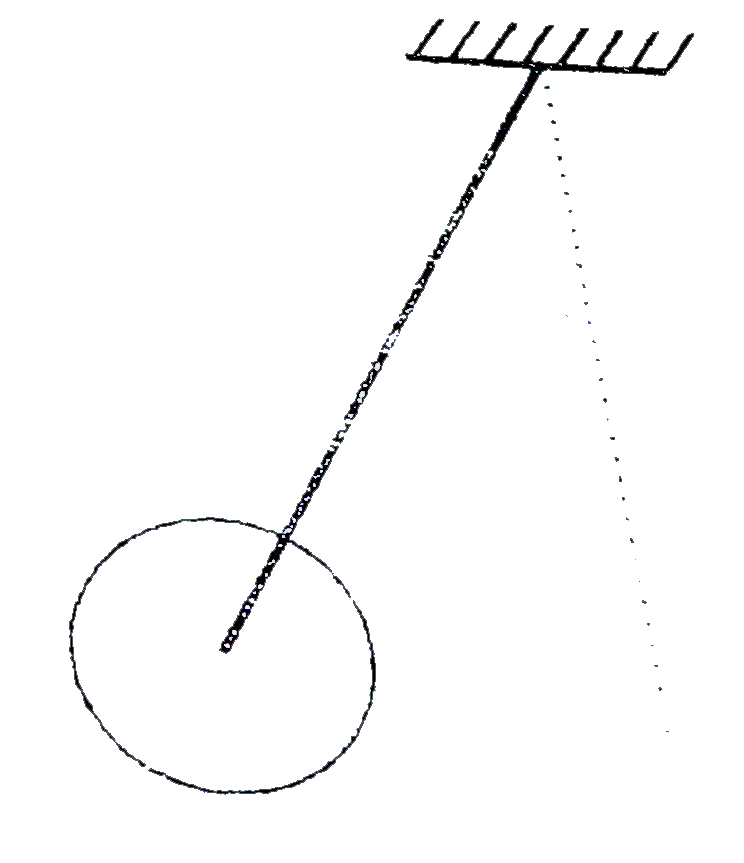
View SolutionA metal rod of length 'L' and mass 'm' is pivoted at one end. A thin disk of mass 'M' and radius 'R' (< L) is attached at its centre to the free end of the rod. Consider two ways the disc is attached: (case A) - The disc is not free to rotate about its centre and (case B) - the disc is free to rotate about its centre. The rod-disc system after being released from the same displaced position. Which of the following statement(s) is(are) true?
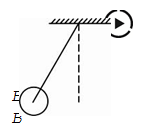
View SolutionFig. 2.44 shows the velocity-time graph of a particle moving in a straight line.
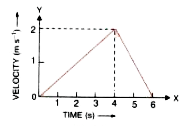
(i) State the nature of motion of particle.
(ii) Find the displacement of particle at t = 6 s.
(iii) Does the particle change its direction of motion ?
(iv) Compare the distance travelled by the particle from 0 to 4 s and from 4 s to 6 s.
(v) Find the acceleration from 0 to 4 s and retardation from 4 s to 6 s.
View SolutionGiven below are some examples of wave motion. State in each case, if the wave motion is transverse, longitudinal or a combination of both?
(i) Motion of a kink in a long coil spring produced by displacing one end of spring side ways.
(ii) Waves produed in a cylinder containing a liquid by moving its piston back and forth.
(iii) Waves produed by a motor boat sailing in water.
(iv) Light waves travelling from sun to earth.
(v) ultrasonic waves in air produced by a vibrating quartz crystal.
View SolutionGiven below are some examples of wave motion. State in each case if the wave motion is transverse, longitudinal or a combination of both
(i) Motion of a kink in a long coil spring, produced by displacing one end of the spring sideways.
(ii) Waves produced in a cylinder containing a liquid, by moving its piston back and forth.
(iii) Waves produced by a motor-boar sailing in water.
(iv) Light waves travelling from the sun to the earth.
(v) Ultrasonic waves in air, produced by a vibrating quartz crystal.
View SolutionThe general motion of a rigid body can be considered to be a combination of (i) a motion …. of its centre of mass about an axis, and (ii) its motion about an instantaneous axis passing through the centre of mass. These axes need not be stationary. Consider, for example, a thin uniform disc welded (rigidly fixed) horizontally at its rim to a massless stick, as shown in the figure. When the disc-stick system is rotated about the origin on a horizontal frictionless plane with angular speed ω , the motion at any instant can be taken as a combination of (i) a rotation of the centre of mass of the disc about the z-axis, and (ii) a rotation of the disc through an instantaneous vertical axis passing through its centre of mass (as is seen from the changed orientation of points P and Q). Both these motions have the same angular speed ω in this case.

Now consider two similar systems as shown in the figure: case (a) the disc with its face vertical and parallel to x-z plane, case (b) the disc with its face making an angle of 45° with x-y plane and its horizontal diameter parallel to x-axis. In both the cases, the disc is welded at point P, and the system are rotated with constant angular speed ω about the z-axis
Which of the following statement regarding the angular speed about the instantaneous axis (passing through the centre of mass) is correct ?
View SolutionThe general motion of a rigid body can be considered to be a combination of (i) a motion of its centre of mass about an axis, and (ii) its motion about an instantaneous exis passing through the centre of mass. These axes need not be stationary. Consider, for example, a thin uniform disc welded (rigidly fixed) horizontally at its rim to a massless, stick as shown in the figure. When the disc-stick system is rotated about the origin on a horizontal frictionless plane with angular speed ω the motion at any instant can be taken as a combination of (i) a rotation of the disc through an instantaneous vertical axis passing through its centre of mass (as is seen from the changed orientation of points P and Q). Both these motions have the same angular speed ω in this case
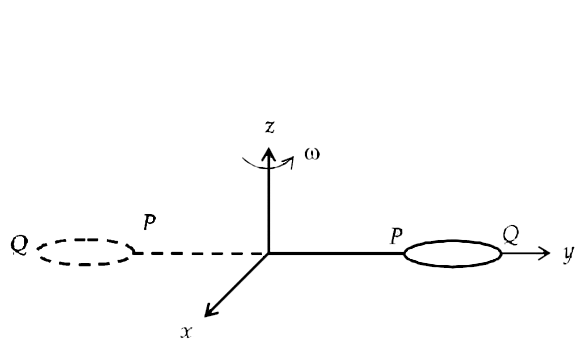
Now consider two similar system as shown in the figure: Case (a) the disc with its face vertical and parallel to x-z plane, Case (b) the disc with its face making an angle of 45∘ with x-y plane and its horizontal diameter parallel to x-axis. In both the cases, the disc is welded at point P, and the systems are rotated with constant angular speed ω about the z-axis.
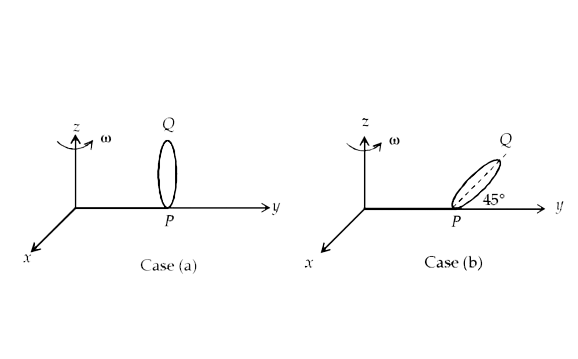
Which of the following statements regarding the angular speed about the instantaneous axis (passing through the centre of mass) is correct?
View Solution
